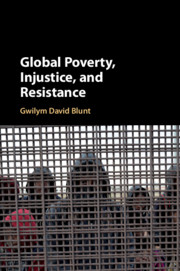Book contents
- Global Poverty, Injustice, and Resistance
- Global Poverty, Injustice, and Resistance
- Copyright page
- Dedication
- Contents
- Acknowledgements
- Introduction
- Chapter 1 Global Poverty, Justice, and Intransigent Non-compliance
- Chapter 2 The Right to Resistance
- Chapter 3 Does Global Poverty Trigger the Right to Resistance?
- Chapter 4 Illegal Immigration as Resistance to Global Poverty
- Chapter 5 Transnational Social Movements, Solidarity, and Resistance
- Chapter 6 Redistributive War as Resistance
- Chapter 7 Armed Struggle and Global Poverty
- Chapter 8 Duties of Resistance
- Conclusion
- Bibliography
- Index
Chapter 5 - Transnational Social Movements, Solidarity, and Resistance
Published online by Cambridge University Press: 02 December 2019
- Global Poverty, Injustice, and Resistance
- Global Poverty, Injustice, and Resistance
- Copyright page
- Dedication
- Contents
- Acknowledgements
- Introduction
- Chapter 1 Global Poverty, Justice, and Intransigent Non-compliance
- Chapter 2 The Right to Resistance
- Chapter 3 Does Global Poverty Trigger the Right to Resistance?
- Chapter 4 Illegal Immigration as Resistance to Global Poverty
- Chapter 5 Transnational Social Movements, Solidarity, and Resistance
- Chapter 6 Redistributive War as Resistance
- Chapter 7 Armed Struggle and Global Poverty
- Chapter 8 Duties of Resistance
- Conclusion
- Bibliography
- Index
Summary
Transnational social movements are social organisations and processes that reach across borders to unite social movements. They are a likely platform for civil resistance, understood as organised but non-violent resistance to injustice that steps outside the realm of accepted political discourse. This is highly contextual. The labour movement in the Global North, for example, does not regularly engage in civil resistance because it operates within liberal democratic norms, while in the Global South trade unionism often carries with it extreme risks.
Transnational social movements are potential sources of solidarity amongst the global poor. This because they generate solidarity amongst distant strangers. This is not solidarity derived from abstract political principles, but derived from the shared experience of oppression. This shared experience need not be uniform; it is necessarily diverse.
The chapter looks at two test cases, the labour movement and indigenous rights movement, as examples of just-seeking and injustice-evading resistance. It concludes by examining criticism that civil resistance does not capture the urgency of global poverty.
Keywords
- Type
- Chapter
- Information
- Global Poverty, Injustice, and Resistance , pp. 121 - 155Publisher: Cambridge University PressPrint publication year: 2019

